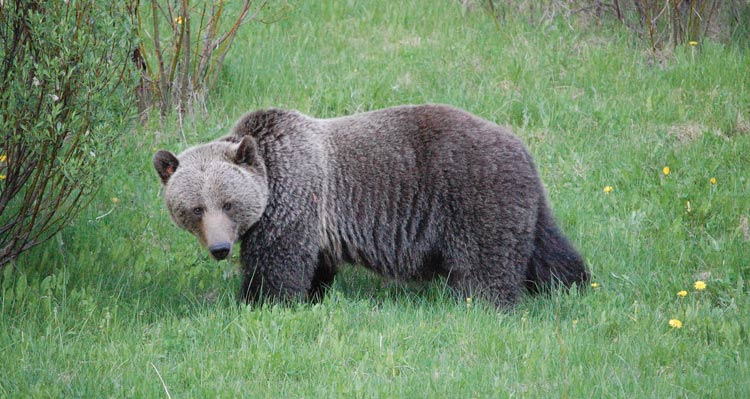Spotting a bear in the wild is a thrill. But it's not easy and safety should always be the top concern — both your own safety and the bear's. And it's important for visitors to understand the realities of wildlife in Banff.
You probably have questions about seeing bears in Banff. Here are some helpful answers!
Seeing a bear in the wild is a rare and treasured experience. If you are determined and you are aware of all the safety precautions (see below), you may count yourself among the lucky visitors who see wild bears in Banff. A few good spots to potentially see bears in the wild include the Bow Valley Parkway (Highway 1A) and the Icefields Parkway (Highway 93-N).
Your chances are always greatest of spotting wildlife at dawn or dusk. Get up early to catch bears and other animals during their active feeding hours. Bears are generally out of hibernation from early April through November.
Bears are solitary, wary and sensitive to human activity. They can be dangerous. The safest bet is to avoid encounters with them altogether — both for their sake and yours.
Here are a few ways to avoid an encounter while out hiking or biking in the mountains, as suggested by Parks Canada:

If you run into a bear, stop where you are and remain calm. Get ready to use your bear spray. Do not run away. Move away slowly and carefully. For a full rundown of the important steps to take if and when you see a bear, follow these instructions from Parks Canada.
It's exciting to spot a bear. Slow down but maintain a respectful distance. For the bear's sake, consider not stopping and letting it forge and feed at its will. Be aware of traffic. Remain in your car. And never, ever feed a bear. Follow Parks Canada's tips for what we call "bear jams" — a traffic jam caused by people viewing a bear on the road from inside their cars.

It’s pretty easy to identify a grizzly, if you happen to see one. You may already know that colour is not an indicator. Grizzlies can be black; black bears can be white. Both species come in many colours. The most noticeable differences between black bears and grizzlies are in their snout and back. Here are the key differences:
While the prairie population of grizzly bears is locally extinct in Alberta, according to Parks Canada there are around 20,000 Grizzlies in western Alberta, the Yukon, Northwest Territories and British Columbia.

Bears on Banff Avenue? Maybe not, but bears have a keen sense of smell and certain attractants like food, or just the smell of food and garbage, is enough to draw a bear into residential neighbourhoods. The Town of Banff and Hamlet of Lake Louise take bear safety very seriously. As a visitor, it's important that you do as well. Take a few precautions to protect both bears and humans:
Make a stop at the Parks Canada Information Centres in Banff, Lake Louise or Jasper and ask all the questions you can think of about bears and bear safety. It's extremely important to be educated, in order to protect both bears and yourselves.
For more information visit Parks Canada online.
Insider tips, inspiration and deals — delivered straight to your inbox.